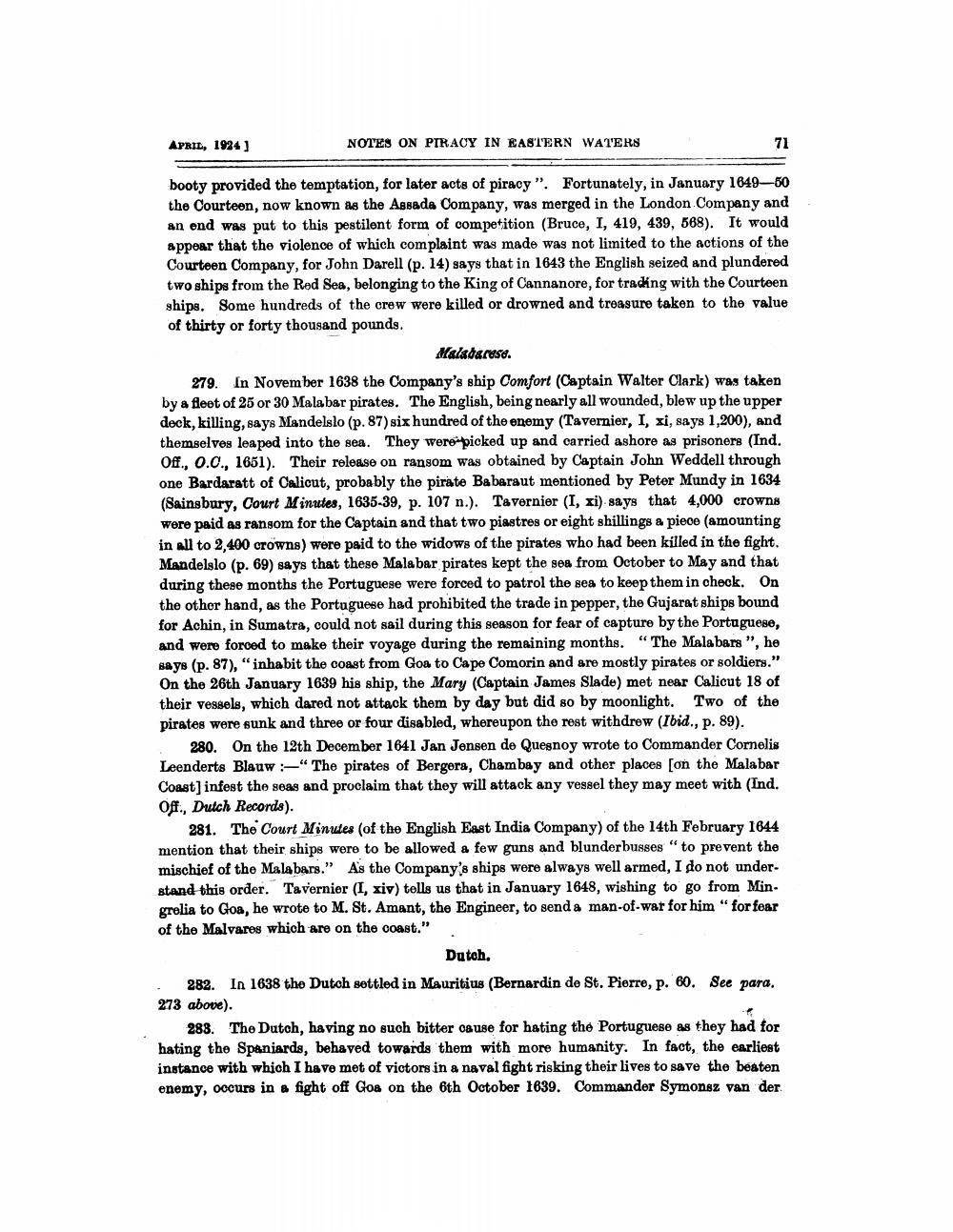________________
APRIL, 1924]
NOTES ON PIRACY IN EASTERN WATERS
71
booty provided the temptation, for later acts of piracy". Fortunately, in January 1649-50 the Courteen, now known as the Assada Company, was merged in the London Company and an end was put to this pestilent form of competition (Bruce, I, 419, 439, 568). It would appear that the violence of which complaint was made was not limited to the actions of the Courteen Company, for John Darell (p. 14) says that in 1643 the English seized and plundered two ships from the Red Sea, belonging to the King of Cannanore, for trading with the Courteen ships. Some hundreds of the crew were killed or drowned and treasure taken to the value of thirty or forty thousand pounds.
Malabarese.
279. In November 1638 the Company's ship Comfort (Captain Walter Clark) was taken by a fleet of 25 or 30 Malabar pirates. The English, being nearly all wounded, blew up the upper deck, killing, says Mandelslo (p. 87) six hundred of the enemy (Tavernier, I, xi, says 1,200), and themselves leaped into the sea. They were picked up and carried ashore as prisoners (Ind. Off., O.C., 1651). Their release on ransom was obtained by Captain John Weddell through one Bardaratt of Calicut, probably the pirate Babaraut mentioned by Peter Mundy in 1634 (Sainsbury, Court Minutes, 1635-39, p. 107 n.). Tavernier (I, xi) says that 4,000 crowns were paid as ransom for the Captain and that two piastres or eight shillings a piece (amounting in all to 2,400 crowns) were paid to the widows of the pirates who had been killed in the fight. Mandelslo (p. 69) says that these Malabar pirates kept the sea from October to May and that during these months the Portuguese were forced to patrol the sea to keep them in check. On the other hand, as the Portuguese had prohibited the trade in pepper, the Gujarat ships bound for Achin, in Sumatra, could not sail during this season for fear of capture by the Portuguese, and were forced to make their voyage during the remaining months. "The Malabars ", he says (p. 87), "inhabit the coast from Goa to Cape Comorin and are mostly pirates or soldiers." On the 26th January 1639 his ship, the Mary (Captain James Slade) met near Calicut 18 of their vessels, which dared not attack them by day but did so by moonlight. Two of the pirates were sunk and three or four disabled, whereupon the rest withdrew (Ibid., p. 89).
280. On the 12th December 1641 Jan Jensen de Quesnoy wrote to Commander Cornelis Leenderts Blauw:-"The pirates of Bergera, Chambay and other places [on the Malabar Coast] infest the seas and proclaim that they will attack any vessel they may meet with (Ind. Off., Dutch Records).
281. The Court Minutes (of the English East India Company) of the 14th February 1644 mention that their ships were to be allowed a few guns and blunderbusses "to prevent the mischief of the Malabars." As the Company's ships were always well armed, I do not understand this order. Tavernier (I, xiv) tells us that in January 1648, wishing to go from Mingrelia to Goa, he wrote to M. St. Amant, the Engineer, to send a man-of-war for him "for fear of the Malvares which are on the coast."
Dutch.
282. In 1638 the Dutch settled in Mauritius (Bernardin de St. Pierre, p. 60. See para. 273 above).
288. The Dutch, having no such bitter cause for hating the Portuguese as they had for hating the Spaniards, behaved towards them with more humanity. In fact, the earliest instance with which I have met of victors in a naval fight risking their lives to save the beaten enemy, occurs in a fight off Goa on the 6th October 1639. Commander Symonsz van der




